
Specialty construction contractor company EMCOR (NYSE:EME) missed Wall Street’s revenue expectations in Q4 CY2024, but sales rose 9.6% year on year to $3.77 billion. On the other hand, the company’s full-year revenue guidance of $16.5 billion at the midpoint came in 4.5% above analysts’ estimates. Its GAAP profit of $6.32 per share was 9.1% above analysts’ consensus estimates.
Is now the time to buy EMCOR? Find out by accessing our full research report, it’s free.
EMCOR (EME) Q4 CY2024 Highlights:
- Revenue: $3.77 billion vs analyst estimates of $3.79 billion (9.6% year-on-year growth, 0.6% miss)
- EPS (GAAP): $6.32 vs analyst estimates of $5.79 (9.1% beat)
- Adjusted EBITDA: $372.5 million vs analyst estimates of $390.5 million (9.9% margin, 4.6% miss)
- Management’s revenue guidance for the upcoming financial year 2025 is $16.5 billion at the midpoint, beating analyst estimates by 4.5% and implying 13.3% growth (vs 16% in FY2024)
- EPS (GAAP) guidance for the upcoming financial year 2025 is $23.13 at the midpoint, in line with analyst estimates
- Operating Margin: 10.3%, up from 8.4% in the same quarter last year
- Free Cash Flow Margin: 12%, similar to the same quarter last year
- Market Capitalization: $18.31 billion
Tony Guzzi, Chairman, President, and Chief Executive Officer of EMCOR, commented, “The Company reported outstanding results for the fourth quarter and full year of 2024. We achieved record revenues, operating income, operating margin, and diluted earnings per share for both the quarter and annual periods, reflecting strong demand for our services and exceptional execution by our team. Looking ahead, we anticipate continued momentum in demand, as evidenced by the 14.2% year-over-year increase in our remaining performance obligations. "
Company Overview
Through its network of over 70 subsidiaries, EMCOR (NYSE:EME) provides electrical, mechanical, and building construction and services
Engineering and Design Services
Companies providing engineering and design services boast ever-evolving technical expertise. Compared to their counterparts who manufacture and sell physical products, these companies can also pivot faster to more trending areas due to their smaller physical asset bases. Green energy and water conservation, for example, are current themes driving incremental demand in this space. On the other hand, those providing engineering and design services are at the whim of construction and infrastructure project volumes, which tend to be cyclical and can be impacted heavily by economic factors such as interest rates.
Sales Growth
Examining a company’s long-term performance can provide clues about its quality. Any business can put up a good quarter or two, but the best consistently grow over the long haul. Luckily, EMCOR’s sales grew at a solid 9.7% compounded annual growth rate over the last five years. Its growth surpassed the average industrials company and shows its offerings resonate with customers, a great starting point for our analysis.
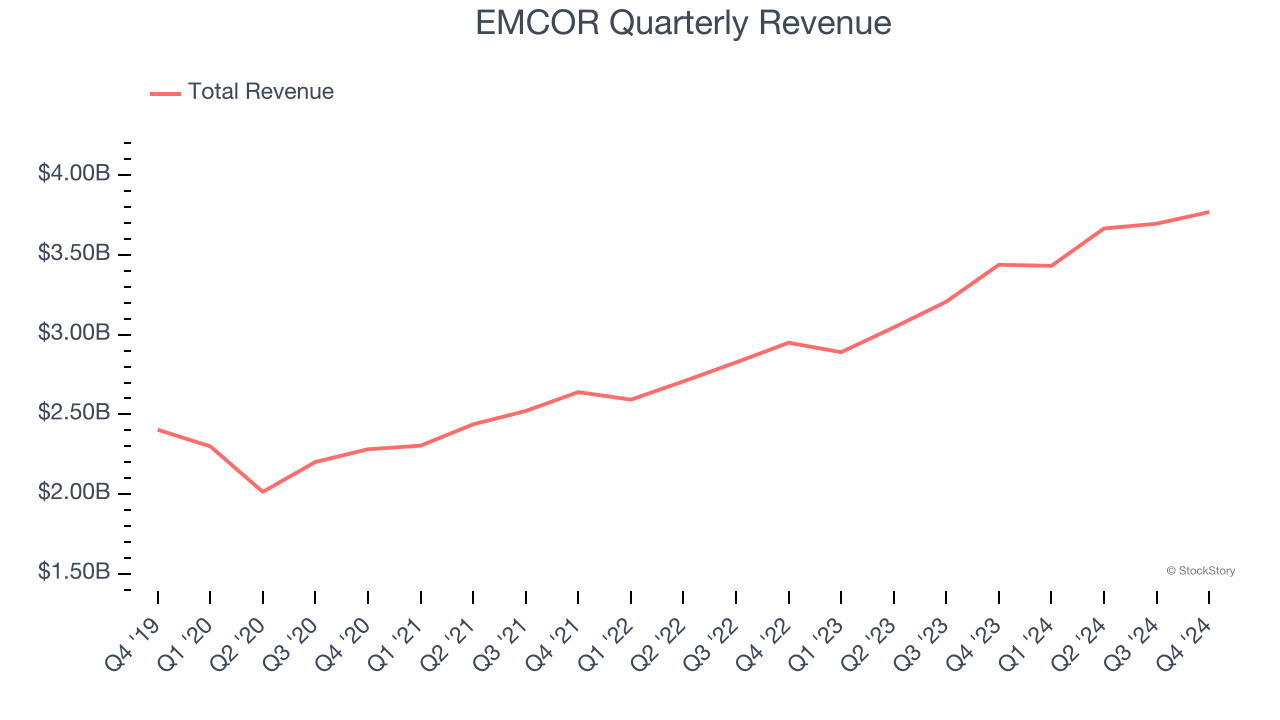
We at StockStory place the most emphasis on long-term growth, but within industrials, a half-decade historical view may miss cycles, industry trends, or a company capitalizing on catalysts such as a new contract win or a successful product line. EMCOR’s annualized revenue growth of 14.7% over the last two years is above its five-year trend, suggesting its demand was strong and recently accelerated. 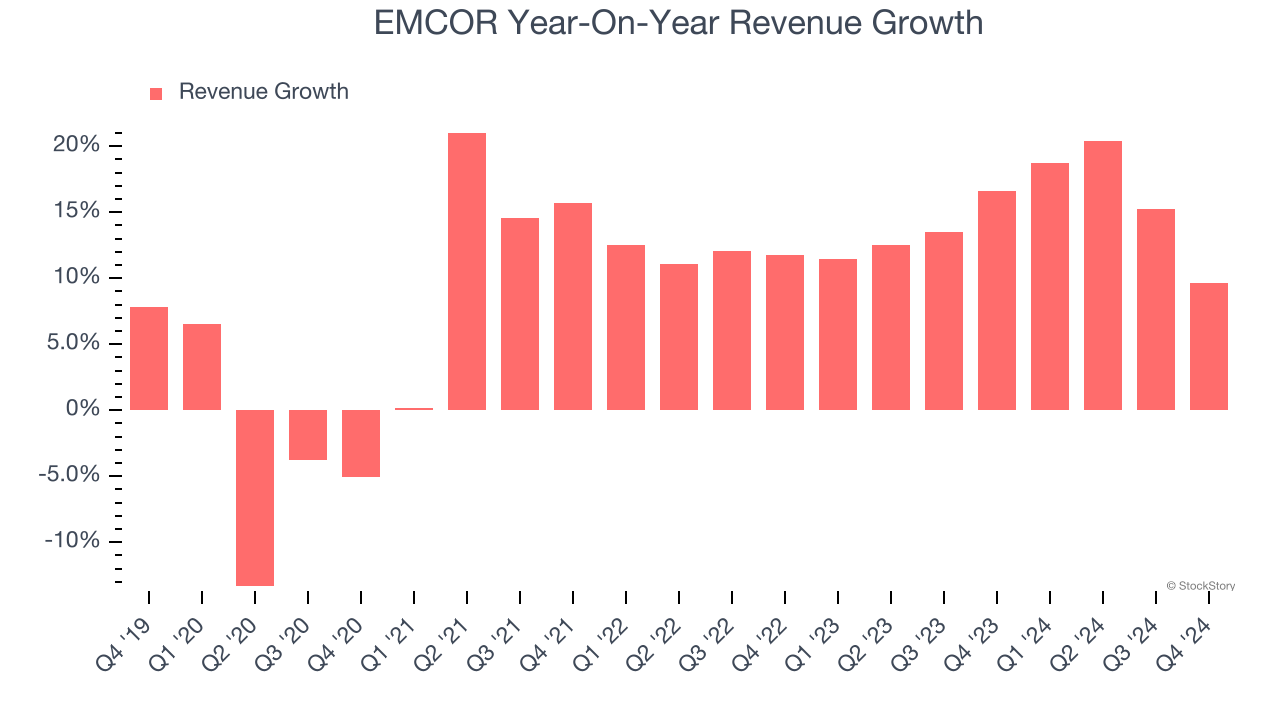
We can dig further into the company’s revenue dynamics by analyzing its most important segments, Mechanical Construction and Facilities Services and Building Services , which are 44% and 20% of revenue. Over the last two years, EMCOR’s Mechanical Construction and Facilities Services revenue (design, integration, installation) averaged 22.5% year-on-year growth while its Building Services revenue (maintenance, electrical, plumbing) averaged 6.7% growth.
This quarter, EMCOR’s revenue grew by 9.6% year on year to $3.77 billion, missing Wall Street’s estimates.
Looking ahead, sell-side analysts expect revenue to grow 8.3% over the next 12 months, a deceleration versus the last two years. We still think its growth trajectory is satisfactory given its scale and suggests the market is baking in success for its products and services.
Unless you’ve been living under a rock, it should be obvious by now that generative AI is going to have a huge impact on how large corporations do business. While Nvidia and AMD are trading close to all-time highs, we prefer a lesser-known (but still profitable) stock benefiting from the rise of AI. Click here to access our free report one of our favorites growth stories.
Operating Margin
Operating margin is an important measure of profitability as it shows the portion of revenue left after accounting for all core expenses – everything from the cost of goods sold to advertising and wages. It’s also useful for comparing profitability across companies with different levels of debt and tax rates because it excludes interest and taxes.
EMCOR was profitable over the last five years but held back by its large cost base. Its average operating margin of 6.3% was weak for an industrials business. This result isn’t too surprising given its low gross margin as a starting point.
On the plus side, EMCOR’s operating margin rose by 6.3 percentage points over the last five years, as its sales growth gave it immense operating leverage.
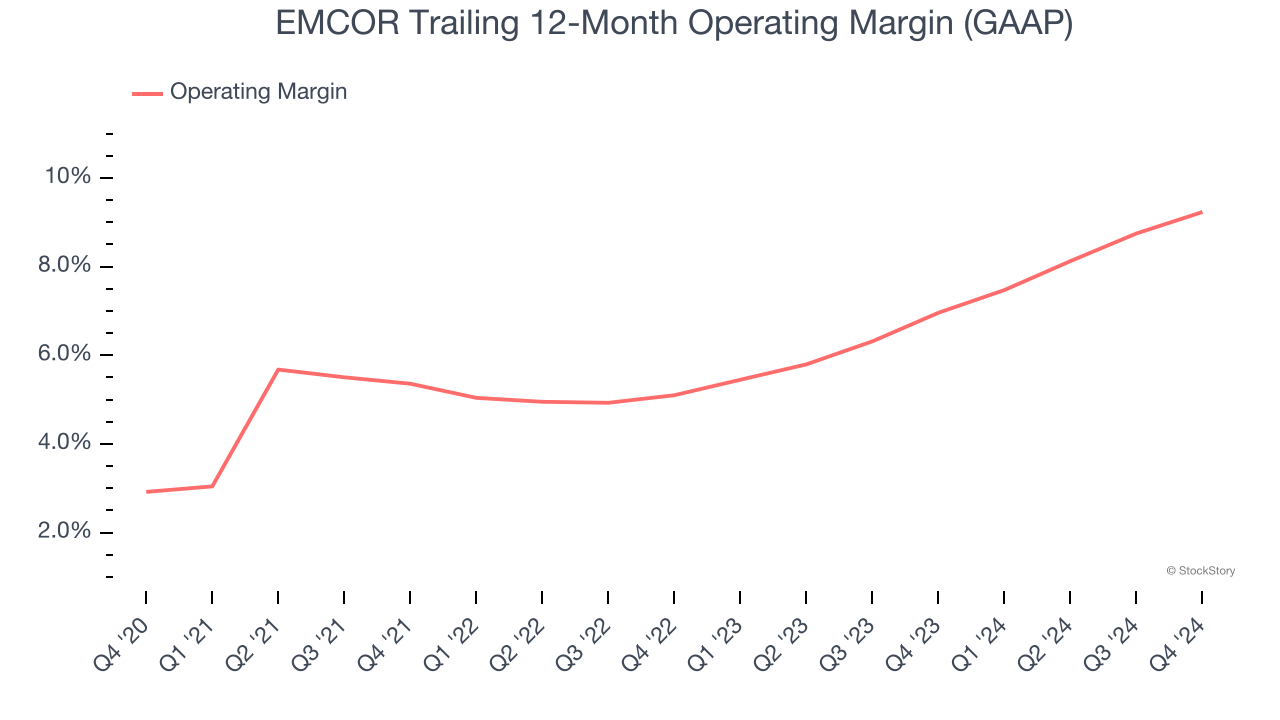
This quarter, EMCOR generated an operating profit margin of 10.3%, up 1.9 percentage points year on year. Since its gross margin expanded more than its operating margin, we can infer that leverage on its cost of sales was the primary driver behind the recently higher efficiency.
Earnings Per Share
Revenue trends explain a company’s historical growth, but the long-term change in earnings per share (EPS) points to the profitability of that growth – for example, a company could inflate its sales through excessive spending on advertising and promotions.
EMCOR’s EPS grew at an astounding 30.2% compounded annual growth rate over the last five years, higher than its 9.7% annualized revenue growth. This tells us the company became more profitable on a per-share basis as it expanded.
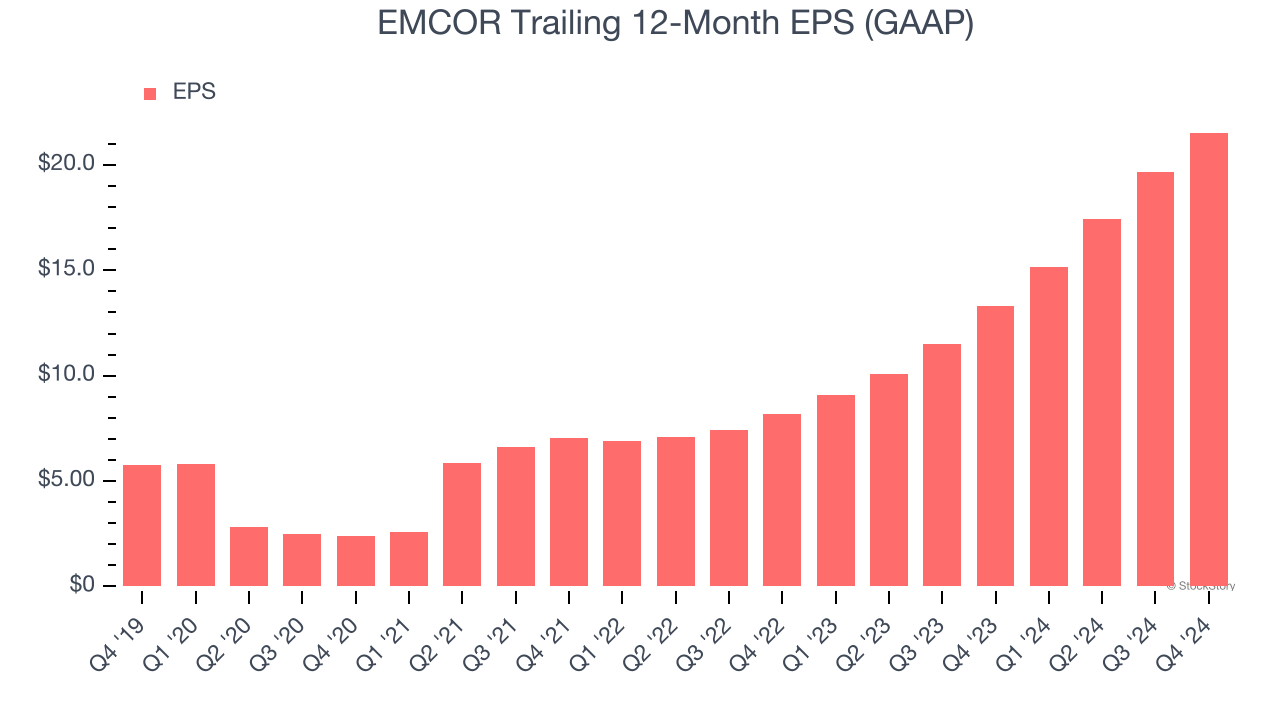
We can take a deeper look into EMCOR’s earnings quality to better understand the drivers of its performance. As we mentioned earlier, EMCOR’s operating margin expanded by 6.3 percentage points over the last five years. On top of that, its share count shrank by 18.4%. These are positive signs for shareholders because improving profitability and share buybacks turbocharge EPS growth relative to revenue growth. 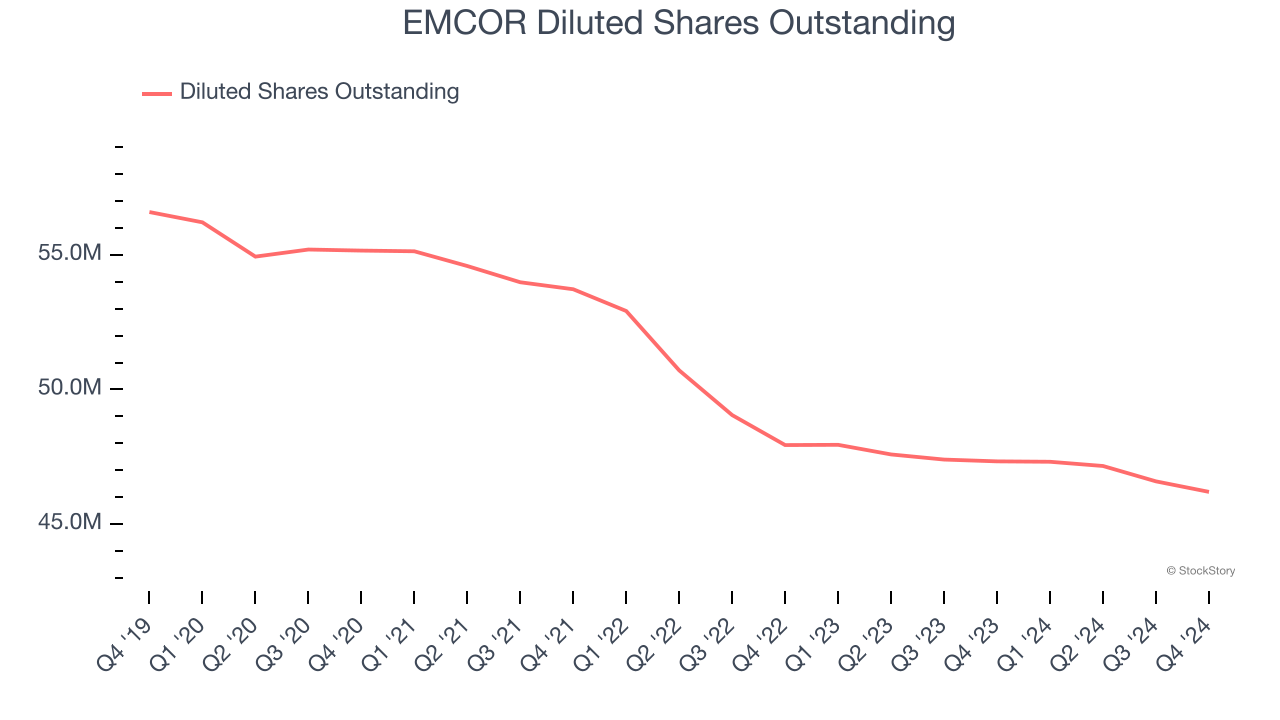
Like with revenue, we analyze EPS over a shorter period to see if we are missing a change in the business.
For EMCOR, its two-year annual EPS growth of 62.4% was higher than its five-year trend. We love it when earnings growth accelerates, especially when it accelerates off an already high base.
In Q4, EMCOR reported EPS at $6.32, up from $4.47 in the same quarter last year. This print beat analysts’ estimates by 9.1%. Over the next 12 months, Wall Street expects EMCOR’s full-year EPS of $21.54 to grow 7.2%.
Key Takeaways from EMCOR’s Q4 Results
We were impressed by EMCOR’s optimistic full-year revenue guidance, which blew past analysts’ expectations. We were also happy its EPS outperformed Wall Street’s estimates. On the other hand, its its Mechanical Construction and Facilities Services revenue fell short of Wall Street’s estimates this quarter. The market seems to be focused on the positives, and shares traded up 7.7% to $428.50 immediately after reporting.
Is EMCOR an attractive investment opportunity right now? We think that the latest quarter is only one piece of the longer-term business quality puzzle. Quality, when combined with valuation, can help determine if the stock is a buy. We cover that in our actionable full research report which you can read here, it’s free.
